Bonds and the stock market are interconnected, influencing each other. They impact an investor's risk exposure and returns. During stock market volatility, investors often turn to bonds for safety, and vice versa. Bonds are fixed-income securities where investors lend money to entities like governments or corporations. These entities repay the loan with interest at the bond's maturity date. Conversely, the stock market is a public marketplace for trading equities, or stocks, which grant fractional ownership in a corporation and a share in its assets and earnings. Both bonds and stocks offer unique investment opportunities, making them crucial components of the financial world. Central banks, like the Federal Reserve in the U.S., play a crucial role in influencing the interest rates in the economy. By adjusting monetary policy tools, they can control the short-term interest rate, which in turn affects the interest rates offered on bonds and the borrowing costs for corporations. Changes in interest rates can impact both bond prices and the stock market. As previously mentioned, bond prices and interest rates move inversely. Therefore, when central banks raise interest rates, newly issued bonds offer higher yields, making existing bonds less attractive and reducing their price. On the other hand, higher interest rates can also negatively affect the stock market. Increased borrowing costs can erode corporate profits, leading to lower stock prices. Conversely, a decrease in interest rates can stimulate economic activity and boost the stock market. Inflation is a significant factor for bond investors. High inflation can erode the purchasing power of the fixed interest payments that a bond provides. This makes bonds less attractive, leading to lower prices. Inflation can also influence the stock market. Moderate inflation is generally a sign of a healthy economy, potentially leading to higher stock prices. However, high inflation can lead to increased input costs for companies, squeezing profit margins and potentially leading to lower stock prices. During periods of economic instability or market volatility, investors often exhibit a "flight to safety". They tend to move their investments from riskier assets like stocks to safer ones like government bonds. This increased demand for bonds drives up their prices. Conversely, the stock market often suffers during these periods of flight to safety. As investors sell their stocks to invest in safer bonds, stock prices can decline. Investor sentiment and risk tolerance play a significant role in the dynamic between bonds and the stock market. When investor sentiment is bullish, risk tolerance is generally higher, favoring the stock market. Conversely, when investor sentiment is bearish, risk tolerance tends to be lower, favoring bonds. Investors often balance their portfolios between bonds and stocks based on their risk tolerance, investment goals, and market outlook. This balancing act can influence the demand and prices in both markets. Bonds serve as a crucial tool for entities like governments and corporations to raise capital. Broadly speaking, there are three types of bonds: Government bonds are issued by national governments to fund public projects or manage national debt levels. Examples include U.S. Treasury bonds, UK Gilts, and German Bunds. These bonds are typically considered low risk because they're backed by the creditworthiness of the respective government. Corporate bonds are issued by companies seeking to raise capital for business expansions, acquisitions, or other operational needs. The risk and return on these bonds are generally higher than government bonds, as they depend on the issuing company's financial health. Municipal bonds are issued by local government entities, such as cities or counties, to finance public projects like infrastructure development or school construction. The interest earned on these bonds is often tax-exempt, making them attractive to certain investors. Bonds exhibit some unique characteristics that investors must understand: Bond prices and interest rates have an inverse relationship. When interest rates rise, bond prices fall, and vice versa. This relationship exists because as interest rates increase, newly issued bonds become more attractive (as they offer higher returns), reducing the demand for existing bonds and hence, their price. The maturity of a bond is the date when the issuer must pay back the principal amount. Bonds can be short-term (less than three years), medium-term (four to ten years), or long-term (more than ten years). Typically, longer-term bonds have higher interest rates to compensate for the increased risk of holding the bond over a longer period. The credit quality of a bond refers to the issuer's ability to meet their debt obligations. Credit rating agencies, such as Standard & Poor's, Moody's, and Fitch Ratings, provide ratings that assess the creditworthiness of bond issuers. A higher rating signifies lower credit risk. Despite being considered safer than stocks, bonds do carry certain risks. These include interest rate risk (the risk that rising interest rates will decrease the value of a bond), credit risk (the risk that the bond issuer will default on their payments), and inflation risk (the risk that inflation will erode the purchasing power of the bond's fixed interest payments). The stock market is a collection of exchanges and other entities where the trading of stocks and other types of securities occur. It facilitates the buying and selling of stocks between buyers and sellers, helping businesses raise capital and offering investors a way to grow their wealth. Several key factors can influence stock prices: A company's earnings and revenue are vital indicators of its financial health. Positive earnings reports often lead to an increase in the company's stock price, while negative reports usually result in a price decrease. Interest rates can impact the stock market as they influence borrowing costs. Higher interest rates can decrease business profitability by increasing borrowing costs, potentially leading to a decrease in stock prices. Inflation represents the rate at which the general level of prices for goods and services is rising. High inflation can erode purchasing power and increase the costs of goods, which can negatively impact corporate profits and, in turn, stock prices. Economic indicators, such as GDP growth, unemployment rate, and consumer confidence index, also influence stock prices by providing insight into the overall health of the economy. Investing in the stock market comes with a set of risks. Market risk, or the possibility that stock prices in general will decline, is a prominent one. Additionally, business risk pertains to factors that can negatively impact a specific company or industry, while liquidity risk refers to the possibility of not being able to buy or sell stocks quickly enough to prevent or minimize a loss. Successful investing requires understanding market conditions, including interest rates, inflation, and economic indicators. Investors should also keep an eye on monetary policy announcements from central banks, as these can significantly impact both bond and stock markets. Diversification, or spreading investments across a variety of assets, is a key strategy for managing risk. A diversified portfolio might include a mix of bonds and stocks, which can help cushion the impact of volatility in any one asset class. Although timing the market perfectly is nearly impossible, investors can still follow some strategies to optimize their buying and selling decisions. For instance, some investors prefer to buy stocks when prices are low, hoping to sell them when prices rise. On the other hand, bond investors might prefer to buy when interest rates are high, securing a higher yield. Finally, investors should consider their investment horizon. Long-term investing involves buying and holding assets with the expectation that they will increase in value over the long term. In contrast, short-term trading involves buying and selling assets over shorter periods to profit from price fluctuations. Both strategies have their merits and risks and should be chosen based on the individual investor's goals, risk tolerance, and time availability. Bonds play a significant role in the dynamics of the stock market. Their influence is noticeable through mechanisms such as interest rates, inflation, and investor behavior during economic uncertainty. Movements in bond prices and yields often provide essential signals about the overall economic health, investor sentiment, and future monetary policy actions, all of which can significantly impact stock market trends. Hence, a profound understanding of this relationship is crucial for investors to navigate these markets effectively. In an ever-evolving financial landscape, it can be beneficial to seek professional assistance. Don't hesitate to reach out to wealth management services that can help guide you through the complexities of investing, taking into account your financial goals, risk tolerance, and investment horizon.Overview of Bonds and the Stock Market
Connection Between Bonds and the Stock Market
Interest Rate Connection
Central Banks and Interest Rates
How Changes in Interest Rates Impact Bond Prices and Stock Market
Inflation Perspective
Impact of Inflation on Bonds
Impact of Inflation on the Stock Market
Flight to Safety During Economic Uncertainty
Preference for Bonds During Economic Instability
Impact on the Stock Market during Flight to Safety
Investor Sentiment and Risk Tolerance
Shifts in Investor Behavior
Balancing Between Bonds and Stocks
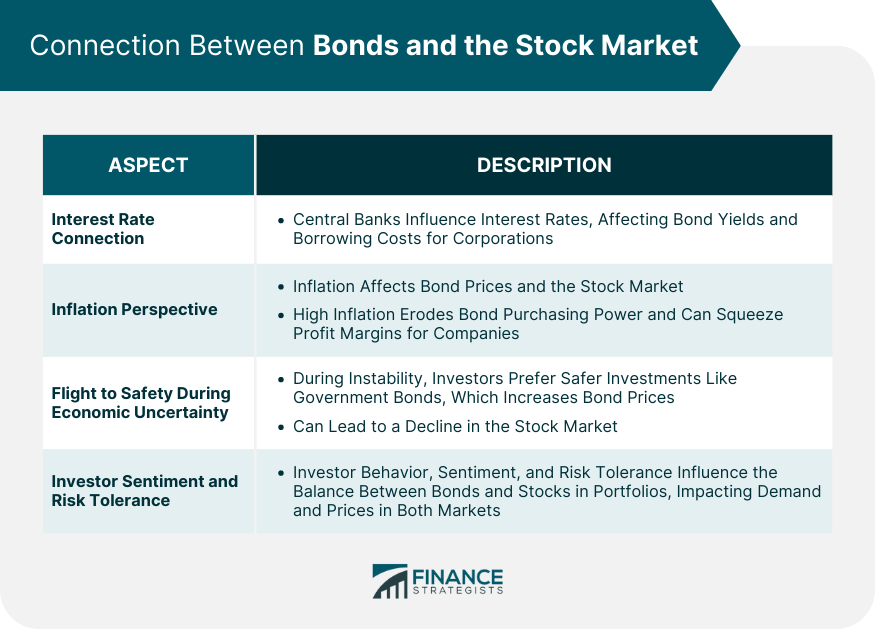
Understanding Bonds
Government Bonds
Corporate Bonds
Municipal Bonds
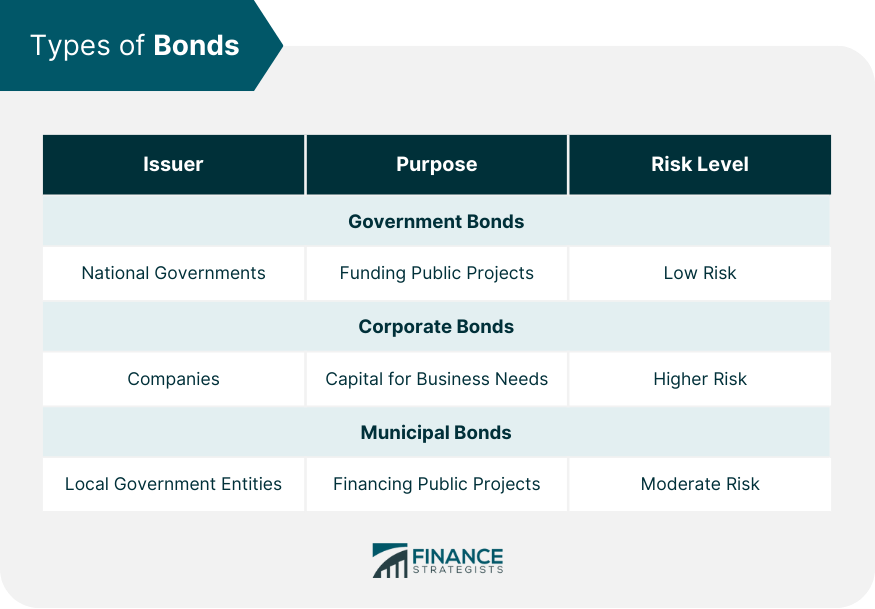
How Bonds Work
Bond Prices and Interest Rates
Bond Maturities
Credit Quality
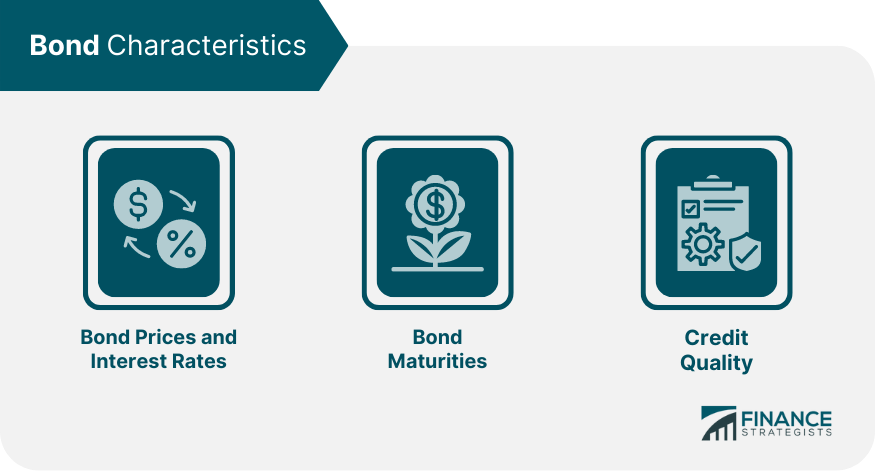
Risks Involved in Investing in Bonds
Understanding the Stock Market
Factors Influencing Stock Prices
Earnings and Revenue
Interest Rates
Inflation
Economic Indicators
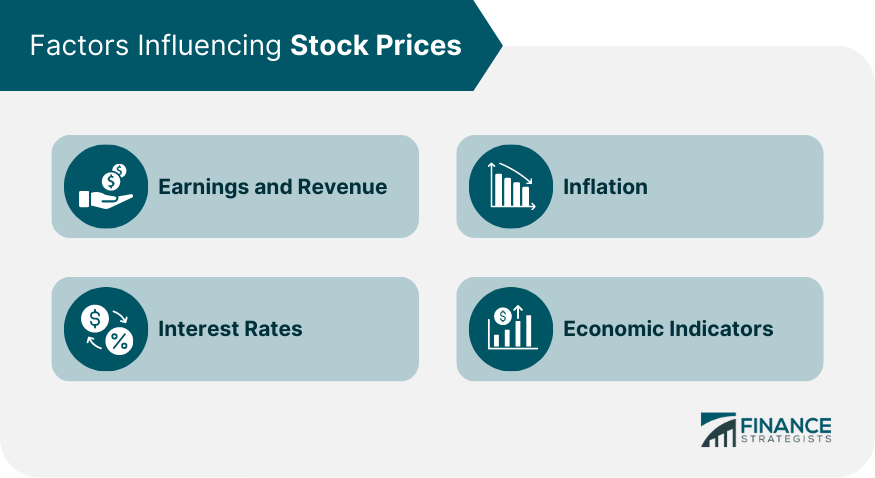
Risks Involved in Investing in the Stock Market
Strategies for Investors
Understanding Market Conditions
Diversification in Portfolio
Timing the Market: Buying and Selling Strategies
Long-Term Investing vs Short-Term Trading
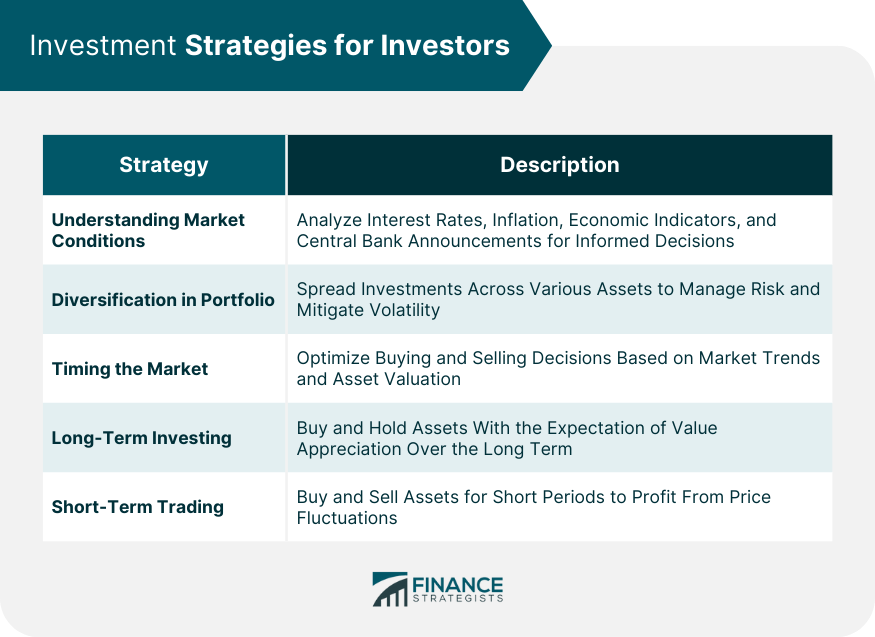
Bottom Line
How Bonds Affect the Stock Market FAQs
Bonds impact the stock market primarily through interest rates and investor sentiment. When interest rates rise, bond prices fall, making new bonds more attractive than stocks. During economic instability, investors may move to the relative safety of bonds, potentially driving down stock prices.
Generally, during periods of economic uncertainty or stock market volatility, bonds, particularly government bonds, may go up in value as investors look for safer investments, while stock prices may decline.
Interest rates impact the cost of borrowing money. When interest rates rise, newly issued bonds offer higher yields, making existing bonds less attractive. Higher interest rates can also make borrowing more expensive for companies, potentially leading to lower corporate profits and lower stock prices.
When the economy is doing well, interest rates often rise to control inflation, leading to lower bond prices. Additionally, investors may shift towards riskier assets like stocks, further lowering demand and prices for bonds.
Diversifying your portfolio by investing in both bonds and stocks can be a good strategy. It can help spread risk and potentially provide a steady income from bond interest payments, along with capital growth from stocks.
True Tamplin is a published author, public speaker, CEO of UpDigital, and founder of Finance Strategists.
True is a Certified Educator in Personal Finance (CEPF®), author of The Handy Financial Ratios Guide, a member of the Society for Advancing Business Editing and Writing, contributes to his financial education site, Finance Strategists, and has spoken to various financial communities such as the CFA Institute, as well as university students like his Alma mater, Biola University, where he received a bachelor of science in business and data analytics.
To learn more about True, visit his personal website or view his author profiles on Amazon, Nasdaq and Forbes.











